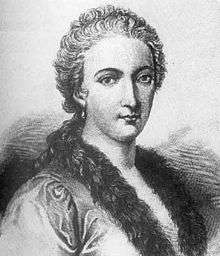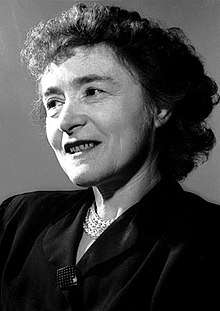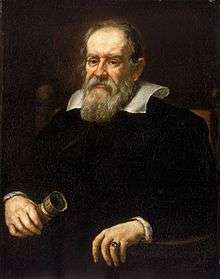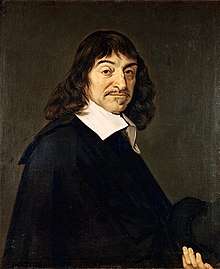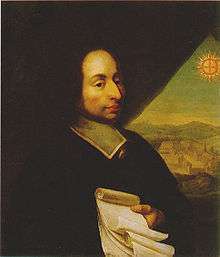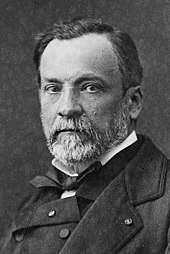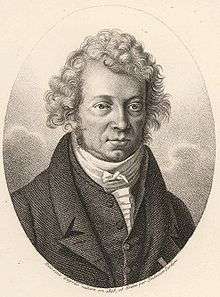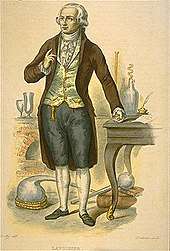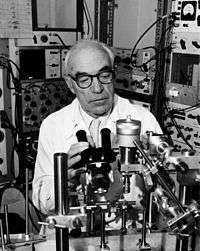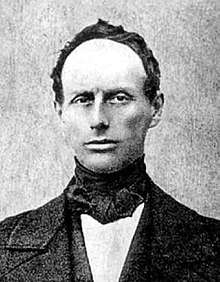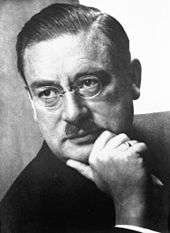List of lay Catholic scientists
Many Catholics have made significant contributions to the development of science and mathematics from the Middle Ages to today. These scientists include Galileo Galilei,[1] René Descartes,[2] Louis Pasteur,[3] Blaise Pascal, André-Marie Ampère, Charles-Augustin de Coulomb, Pierre de Fermat, Antoine Laurent Lavoisier, Alessandro Volta,[4] Augustin-Louis Cauchy, Pierre Duhem, Jean-Baptiste Dumas, Alois Alzheimer, Georgius Agricola, and Christian Doppler.
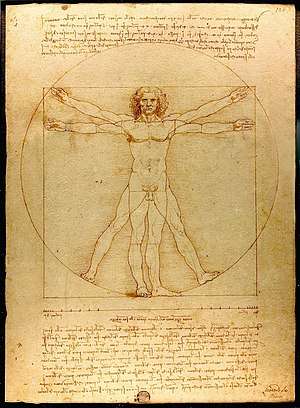
"The Vitruvian Man" by Leonardo da Vinci
For additional Catholic scientists, see the List of Catholic churchmen-scientists.
Catholic scientists
- Maria Gaetana Agnesi (1718–1799) – mathematician who wrote on differential and integral calculus
- Georgius Agricola (1494–1555) – father of mineralogy[5]
- Ulisse Aldrovandi (1522–1605) – father of natural history
- Rudolf Allers (1883–1963) – Austrian psychiatrist; the only Catholic member of Sigmund Freud's first group, later a critic of Freudian psychoanalysis
- Alois Alzheimer (1864–1915) – credited with identifying the first published case of presenile dementia, which is now known as Alzheimer's disease[6]
- André-Marie Ampère (1775–1836) – one of the main discoverers of electromagnetism
- Leopold Auenbrugger (1722–1809) – first to use percussion as a diagnostic technique in medicine
- Adrien Auzout (1622–1691) – astronomer who contributed to the development of the telescopic micrometer
- Amedeo Avogadro (1776–1856) – Italian scientist noted for contributions to molecular theory and Avogadro's Law[7]
- Francisco J. Ayala (1934–) – Spanish-American biologist and philosopher at the University of California, Irvine[8][9]
- Jacques Babinet (1794–1872) – French physicist, mathematician, and astronomer who is best known for his contributions to optics [10]
- Stephen M. Barr (1953–) – professor in the Department of Physics and Astronomy at the University of Delaware and a member of its Bartol Research Institute
- Joachim Barrande (1799–1883) – French geologist and paleontologist who studied fossils from the Lower Palaeozoic rocks of Bohemia [11]
- Laura Bassi (1711–1778) – physicist at the University of Bologna and Chair in experimental physics at the Bologna Institute of Sciences, the first woman to be offered a professorship at a European university
- Antoine César Becquerel (1788–1878) – pioneer in the study of electric and luminescent phenomena
- Henri Becquerel (1852–1908) – awarded the Nobel Prize in physics for his co-discovery of radioactivity
- Carlo Beenakker (1960–) – professor at Leiden University and leader of the university's mesoscopic physics group, established in 1992.
- Giovanni Battista Belzoni (1778–1823) – prolific Italian explorer and pioneer archaeologist of Egyptian antiquities[12]
- Pierre-Joseph van Beneden (1809–1894) – Belgian zoologist and paleontologist who established one of the world's first marine laboratories and aquariums[13]
- Claude Bernard (1813–1878) – physiologist who helped to apply scientific methodology to medicine
- Jacques Philippe Marie Binet (1786–1856) – mathematician known for Binet's formula and his contributions to number theory
- Jean-Baptiste Biot (1774–1862) – physicist who established the reality of meteorites and studied polarization of light
- John Birmingham (astronomer) (1816–1884) – Irish astronomer who discovered the recurrent nova T Coronae Borealis and revised and extended Schjellerup's Catalogue of Red Stars.[14]
- Henri Marie Ducrotay de Blainville (1777–1850) – zoologist and anatomist who coined the term paleontology and described several new species of reptiles[15]
- Giovanni Alfonso Borelli (1608–1679) – often referred to as the father of modern biomechanics
- Raoul Bott (1923–2005) – mathematician known for numerous basic contributions to geometry in its broad sense[16][17]
- Marcella Boveri (1863–1950) – biologist and first woman to graduate from the Massachusetts Institute of Technology
- Theodor Boveri (1862–1915) – first to hypothesize the cellular processes that cause cancer
- Louis Braille (1809–1852) – inventor of the Braille reading and writing system
- Edouard Branly (1844–1940) – inventor and physicist known for his involvement in wireless telegraphy and his invention of the Branly coherer
- James Britten (1846–1924) – botanist, member of the Catholic Truth Society and Knight Commander of the Order of St. Gregory the Great[18]
- Hermann Brück (1905–2000) – Astronomer Royal for Scotland from 1957–1975; honored by Pope John Paul II
- Albert Brudzewski (c. 1445–c.1497) – first to state that the Moon moves in an ellipse
- Georges-Louis Leclerc, Comte de Buffon (1707–1788) – one of the pioneers of natural history, especially through his monumental Histoire Naturelle
- Nicola Cabibbo (1935–2010) – Italian physicist, discoverer of the universality of weak interactions (Cabibbo angle), President of the Pontifical Academy of Sciences from 1993 until his death
- Alexis Carrel (1873–1944) – awarded the Nobel Prize in Medicine for pioneering vascular suturing techniques
- John Casey (mathematician) (1820–1891) – Irish geometer known for Casey's theorem
- Giovanni Domenico Cassini (1625–1712) – first to observe four of Saturn's moons and the co-discoverer of the Great Red Spot on Jupiter
- Augustin-Louis Cauchy (1789–1857) – mathematician who was an early pioneer in analysis
- Andrea Cesalpino (c.1525–1603) – botanist who also theorized on the circulation of blood
- Jean-François Champollion (1790–1832) – published the first translation of the Rosetta Stone
- Michel Chasles (1793–1880) – mathematician who elaborated on the theory of modern projective geometry and was awarded the Copley Medal
- Guy de Chauliac (c.1300–1368) – most eminent surgeon of the Middle Ages
- Chien-jen Chen (1951–) – Taiwanese epidemiologist researching hepatitis B, liver cancer risk of people with hepatitis B, link of arsenic to blackfoot disease, etc.[19]
- Michel Eugène Chevreul (1786–1889) – Considered one of the major figures in the early development of organic chemistry[20]; stated "Those who know me also know that born a Catholic, the son of Christian parents, I live and I mean to die a Catholic"[21]
- Albert Claude (1899–1983) – awarded the Nobel Prize in Medicine for his contributions to cytology
- Mateo Realdo Colombo (1516–1559) – discovered the pulmonary circuit,[22] which paved the way for Harvey's discovery of circulation
- Arthur W. Conway (1876–1950) – remembered for his application of biquaternion algebra to the special theory of relativity
- E. J. Conway (1894–1968) – Irish biochemist known for works pertaining to electrolyte physiology and analytical chemistry[23]
- Carl Ferdinand Cori (1896–1984) – shared the 1947 Nobel Prize in Physiology or Medicine with his wife for their discovery of the Cori cycle
- Gerty Cori (1896–1957) – biochemist who was the first American woman win a Nobel Prize in science (1947)[24]
- Gaspard-Gustave Coriolis (1792–1843) – formulated laws regarding rotating systems, which later became known as the Corialis effect
- Domenico Cotugno (1736–1822) – Italian anatomist who discovered the nasopalatine nerve, demonstrated the existence of the labyrinthine fluid, and formulated a theory of resonance and hearing, among other important contributions
- Maurice Couette (1858–1943) – best known for his contributions to rheology and the theory of fluid flow; appointed a Knight of the Order of St. Gregory the Great by Pope Pius XI in 1925[25]
- Charles-Augustin de Coulomb (1736–1806) – physicist known for developing Coulomb's law
- Clyde Cowan (1919–1974) – co-discoverer of the neutrino
- Jean Cruveilhier (1791–1874) – made important contributions to the study of the nervous system and was the first to describe the lesions associated with multiple sclerosis; originally planned to enter the priesthood
- Endre Czeizel (1935–2015) – Discovered that folic acid prevents or reduces the formation of more serious developmental disorders, such as neural tube defects like spina bifida
- Gabriel Auguste Daubrée (1814–1896) – pioneer in the application of experimental methods to the study of diverse geologic phenomena[26]
- Peter Debye (1884–1966) – Awarded the Nobel Prize in Chemistry in 1936 "for his contributions to our knowledge of molecular structure through his investigations on dipole moments and on the diffraction of X-rays and electrons in gases."[27]
- Charles Enrique Dent (1911–1976) – British biochemist who defined new amino-acid diseases such as various forms of Fanconi syndrome, Hartnup disease, argininosuccinic aciduria and homocystinuria[28]
- René Descartes (1596–1650) – father of modern philosophy and analytic geometry
- César-Mansuète Despretz (1791–1863) – chemist and physicist who investigated latent heat, the elasticity of vapors, the compressibility of liquids, and the density of gases[29]
- Johann Peter Gustav Lejeune Dirichlet (1805–1859) – mathematician who contributed to number theory and was one of the first to give the modern formal definition of a function
- Peter Dodson (1946–) – American paleontologist at the University of Pennsylvania; co-editor of The Dinosauria, widely considered the definitive scholarly reference on dinosaurs
- Ignacy Domeyko (1802–1889) – Polish scientist who made major contributions to the study of Chile's geography, geology, and mineralogy
- Christian Doppler (1803–1853) – Austrian physicist and mathematician who enunciated the Doppler effect
- Pierre Duhem (1861–1916) – historian of science who made important contributions to hydrodynamics, elasticity, and thermodynamics
- Félix Dujardin (1801–1860) – biologist remembered for his research on protozoans and other invertebrates; became a devout Catholic later in life and was known to read The Imitation of Christ[30]
- Jean-Baptiste Dumas (1800–1884) – chemist who established new values for the atomic mass of thirty elements
- André Dumont (1809–1857) – Belgian geologist who prepared the first geological map of Belgium and named many of the subdivisions of the Cretaceous and Tertiary[31]
- Charles Dupin (1784–1873) – mathematician who discovered the Dupin cyclide and the Dupin indicatrix[32]
- John Eccles (1903–1997) – awarded the Nobel Prize in Medicine for his work on the synapse[33]
- Stephan Endlicher (1804–1849) – botanist who formulated a major system of plant classification
- Bartolomeo Eustachi (c.1500–1574) – one of the founders of human anatomy
- Jean-Henri Fabre (1823–1915) – naturalist, entomologist, and science writer; "The Homer of Insects"
- Hieronymus Fabricius (1537–1619) – father of embryology
- Gabriele Falloppio (1523–1562) – pioneering Italian anatomist who studied the human ear and reproductive organs
- Mary Celine Fasenmyer (1906–1996) – religious sister and mathematician, founder of Sister Celine's polynomials
- Hervé Faye (1814–1902) – astronomer whose discovery of the periodic comet 4P/Faye won him the 1844 Lalande Prize and membership in the French Academy of Sciences
- Pierre de Fermat (1601–1665) – number theorist who contributed to the early development of calculus
- Enrico Fermi (1901–1954) – awarded the Nobel Prize in physics for his work in induced radioactivity
- Jean Fernel (1497–1558) – physician who introduced the term physiology
- Fibonacci (c.1170–c.1250) – popularized Hindu-Arabic numerals in Europe and discovered the Fibonacci sequence
- Hippolyte Fizeau (1819–1896) – first person to determine experimentally the velocity of light[34]
- Lawrence Flick (1856–1938) – American physician who pioneered research and treatment of tuberculosis
- Philip G. Fothergill FRSE (1908-1967) – British biologist and historian of science
- Léon Foucault (1819–1868) – invented the Foucault pendulum to measure the effect of the earth's rotation
- Joseph von Fraunhofer (1787–1826) – discovered Fraunhofer lines in the sun's spectrum
- Augustin-Jean Fresnel (1788–1827) – made significant contributions to the theory of wave optics
- Johann Nepomuk von Fuchs (1774–1856) – confirmed the stoichiometric laws and observed isomorphism and the cation exchange of zeolites[35]
- Galileo Galilei (1564–1642) – father of modern science[36]
- Luigi Galvani (1737–1798) – formulated the theory of animal electricity
- Dorothy Annie Elizabeth Garrod (1892–1968) – archaeologist specialised in the Palaeolithic period.
- William Gascoigne (1610–1644) – developed the first micrometer
- Riccardo Giacconi (1931–) – Nobel Prize-winning astrophysicist who laid the foundations of X-ray astronomy
- Paula González (1932–) – religious sister and professor of biology
- Peter Grünberg (1939–2018) – German physicist, Nobel Prize in Physics laureate[37]
- Johannes Gutenberg (c.1398–1468) – inventor of the printing press
- Samuel Stehman Haldeman (1812–1880) – American naturalist and convert to Catholicism who researched fresh-water mollusks, the human voice, Amerindian dialects, and the organs of sound of insects
- Jean Baptiste Julien d'Omalius d'Halloy (1783–1875) – one of the pioneers of modern geology[38]
- Eduard Heis (1806–1877) – astronomer who contributed the first true delineation of the Milky Way
- Jan Baptist van Helmont (1579–1644) – founder of pneumatic chemistry
- Victor Franz Hess (1883-1964) - an Austrian-American physicist, and Nobel laureate in physics, who discovered cosmic rays.
- George de Hevesy (1885–1966) – Hungarian radiochemist and Nobel laureate[39]
- Charles Hermite (1822–1901) – mathematician who did research on number theory, quadratic forms, elliptic functions, and algebra
- John Philip Holland (1840–1914) – developed the first submarine to be formally commissioned by the US Navy
- Antoine Laurent de Jussieu (1748–1836) – first to propose a natural classification of flowering plants
- Mary Kenneth Keller (c.1914–1985) – Sister of Charity and first American woman to earn a PhD in computer science, helped develop BASIC
- Annie Chambers Ketchum (1824–1904) – convert to Catholicism and botanist who published Botany for academies and colleges: consisting of plant development and structure from seaweed to clematis
- Brian Kobilka (1955–) – American Nobel Prize winning professor who teaches at Stanford University School of Medicine[40][41]
- Karl Kreil (1798–1862) – meteorologist and astronomer who conducted important studies of terrestrial magnetism [42]
- Stephanie Kwolek (1923–2014) – chemist who developed Kevlar at DuPont in 1965
- René Laennec (1781–1826) – physician who invented the stethoscope
- Joseph Louis Lagrange (1736–1813) – mathematician and astronomer known for Lagrangian points and Lagrangian mechanics
- Jean-Baptiste Lamarck (1744–1829) – French naturalist, biologist and academic whose theories on evolution preceded those of Darwin
- Johann von Lamont (1805–1879) – astronomer and physicist who studied the magnetism of the Earth and was the first to calculate the mass of Uranus
- Karl Landsteiner (1868–1943) – Nobel Prize winner who identified and classified the human blood types
- Pierre André Latreille (1762–1833) – pioneer in entomology
- Antoine Lavoisier (1743–1794) – father of modern chemistry[43]
- Claude-Nicolas Le Cat (1700–1768) – invented or perfected several instruments for lithotomy and was one of the first adherents of a mechanistic approach to physiology[44]
- Xavier Le Pichon (1937– ) – French geophysicist; known for his comprehensive model of plate tectonics, helping create the field of plate tectonics
- Jérôme Lejeune (1926–1994) – pediatrician and geneticist, best known for his discovery of the link of diseases to chromosome abnormalities
- Jacques Jean Lhermitte (1877–1959) – French neurologist and neuropsychiatrist; clinical director at the Salpêtrière Hospital
- Karl August Lossen (1841–1893) – geologist who mapped and described the Harz Mountains[45]
- Jonathan Lunine (1959–) – planetary scientist at the forefront of research into planet formation, evolution, and habitability; serves as vice-president of the Society of Catholic Scientists[46]
- William James MacNeven (1763–1841) – Irish-American physician and chemist who was an early proponent of atomic theory[47]
- Juan Martín Maldacena (1968–) – Argentine theoretical physicist, first Carl P. Feinberg Professor of Theoretical Physics in the Institute for Advanced Study's School of Natural Sciences, and first proponent of AdS/CFT correspondence[48]
- Marcello Malpighi (1628–1694) – father of comparative physiology[49]
- Étienne-Louis Malus (1775–1812) – discovered the polarization of light
- Anna Morandi Manzolini (1714–1774) – anatomist and anatomical wax artist who lectured at the University of Bologna
- Giovanni Manzolini (1700–1755) – anatomical wax artist and Professor of anatomy at the University of Bologna
- Guglielmo Marconi (1874–1937) – father of wireless technology and radio transmission
- Luigi Ferdinando Marsili (1658–1730) – one of the founders of modern oceanography[50]
- Pierre Louis Maupertuis (1698–1759) – known for the Maupertuis principle and for being the first president of the Berlin Academy of Science
- Michele Mercati (1541–1593) – one of the first to recognize prehistoric stone tools as man-made
- Charles W. Misner (1932–) – American cosmologist dedicated to the study of general relativity
- Kenneth R. Miller (1948–) – American cell biologist and molecular biologist who teaches at Brown University[51]
- Mario J. Molina (1943–) – Mexican chemist, one of the precursors to the discovery of the Antarctic ozone hole (1995 Nobel Prize in Chemistry)
- Peter Joseph Moloney (1891–1989) – Canadian immunologist and pioneering vaccine researcher, who worked out the first large-scale purification of insulin in 1922; International Gairdner Award, 1967)[52]
- Gaspard Monge (1746–1818) – father of descriptive geometry
- John J. Montgomery (1858–1911) – American physicist and inventor of gliders and aerodynamics
- Giovanni Battista Morgagni (1682–1771) – father of modern anatomical pathology[53]
- Johannes Peter Müller (1801–1858) – founder of modern physiology[54]
- Joseph Murray (1919–2012) – Nobel Prize in Medicine laureate[55]
- John von Neumann (1903–1957) – Hungarian-born American mathematician and polymath[56] who converted to Catholicism[57]
- Charles Nicolle (1866–1936) – French bacteriologist who received the 1928 Nobel Prize in Medicine for his identification of lice as the transmitter of epidemic typhus; came back to the Catholic Church at the end of his life
- Martin Nowak (1965–) – evolutionary theorist and Director of the Program for Evolutionary Dynamics at Harvard University; serves on the board of the Society of Catholic Scientists[46]
- Karin Öberg (1982–) – her Öberg Astrochemistry Group discovered the first complex organic molecule in a protoplanetary disk; serves on the board of the Society of Catholic Scientists[46]
- Abraham Ortelius (1527–1598) – created the first modern atlas and theorized on continental drift
- Blaise Pascal (1623–1662) – French mathematician, physicist, inventor, writer and philosopher
- Louis Pasteur (1822–1895) – father of bacteriology[3][58]
- Christopher J. Payne (1988–) – biology professor at Malone University and long-term forest ecologist[59]
- Pierre Joseph Pelletier (1788–1842) – co-discovered strychnine, caffeine, quinine, cinchonine, among many other discoveries in chemistry[60]
- Georg von Peuerbach (1423–1461) – called the father of mathematical and observational astronomy in the West[61]
- Gabrio Piola (1794–1850) – Italian physicist and mathematician who made fundamental contributions to continuum mechanics
- Michael Polanyi (1891–1976) – Hungarian polymath, made contributions to physical chemistry, economics, and philosophy
- Vladimir Prelog (1906–1998) – Croatian-Swiss organic chemist, winner of the 1975 Nobel Prize for chemistry
- Santiago Ramón y Cajal (1852–1934) – awarded the Nobel Prize for his contributions to neuroscience
- Giancarlo Rastelli (1933–1970) – Pioneering cardiac surgeon at the Mayo Clinic who developed the Rastelli procedure; he is a Servant of God in the Catholic Church
- René Antoine Ferchault de Réaumur (1683–1757) – scientific polymath known especially for his study of insects
- Francesco Redi (1626–1697) – his experiments with maggots were a major step in overturning the idea of spontaneous generation
- Henri Victor Regnault (1810–1878) – chemist with two laws governing the specific heat of gases named after him[62]
- Gregorio Ricci-Curbastro (1853–1925) – one of the founders of tensor calculus
- Norbert Rillieux (1806–1894) – a French-speaking Creole, one of the earliest chemical engineers and inventory of the multiple-effect evaporator
- Gilles de Roberval (1602–1675) – mathematician who studied the geometry of infinitesimals and was one of the founders of kinematic geometry
- Clemens C. J. Roothaan (1918–2019) – physicist known for developing the Roothaan equations
- Frederick Rossini (1899–1990) – Priestley Medal and Laetare Medal-winning chemist[63]
- Paolo Ruffini (1765–1822) – Italian mathematician who contributed to the Abel–Ruffini theorem and described Ruffini's rule
- Paul Sabatier (chemist) (1854–1941) – awarded the Nobel Prize in Chemistry for his work improving the hydrogenation of organic species in the presence of metals
- Adhémar Jean Claude Barré de Saint-Venant (1797–1886) – remembered for Saint-Venant's principle, Saint-Venant's theorem, and Saint-Venant's compatibility condition; given the title Count by Pope Pius IX in 1869
- Theodor Schwann (1810–1882) – founder of the theory of the cellular structure of animal organisms
- Ignaz Semmelweis (1818–1865) – early pioneer of antiseptic procedures, discoverer of the cause of puerperal fever
- J. Wolfgang Smith (1930–) – mathematician, physicist, and philosopher of science
- George Sperti (1900–1991) – inventor of Preparation H hemorrhoid medication, the Sperti Ultraviolet Lamp, and Aspercreme; co-founder of the Institutum Divi-Thomae and of the Basic Science Research Laboratory of the University of Cincinnati
- Horatio Storer (1830–1922) – physician; founder of the Gynaecological Society of Boston, the first medical society devoted exclusively to gynecology; leader of the "physicians' crusade against abortion"
- Karl Stern (1906–1975) – German-Canadian neurologist and psychiatrist; lecturer in neuropathology and assistant neuropathologist at the Montreal Neurological Institute
- Louis Jacques Thénard (1777–1857) – discovered hydrogen peroxide and contributed to the discovery of boron[64]
- Evangelista Torricelli (1608–1647) – inventor of the barometer
- Paolo dal Pozzo Toscanelli (1397–1482) – Italian mathematician, astronomer and cosmographer
- Richard Towneley (1629–1707) – mathematician and astronomer whose work contributed to the formulation of Boyle's Law
- Louis René Tulasne (1815–1885) – biologist with several genera and species of fungi named after him
- Louis Nicolas Vauquelin (1763–1829) – discovered the chemical element beryllium
- Urbain Le Verrier (1811–1877) – mathematician who predicted the discovery of Neptune
- Andreas Vesalius (1514–1564) – father of modern human anatomy
- François Viète (1540–1603) – father of modern algebra[65]
- Leonardo da Vinci (1452–1519) – Renaissance anatomist, scientist, mathematician, and painter
- Vincenzo Viviani (1622–1703) – mathematician known for Viviani's theorem, Viviani's curve and his work in determining the speed of sound
- Alessandro Volta (1745–1827) – physicist known for the invention of the battery[4]
- Wilhelm Heinrich Waagen (1841–1900) – geologist and paleontologist who provided the first example of evolution described from the geologic record, after studying Jurassic ammonites[66]
- James Joseph Walsh (1865–1942) – dean and professor of nervous diseases and of the history of medicine at Fordham University; Laetare Medal recipient
- Karl Weierstrass (1815–1897) – often called the father of modern analysis[67]
- E. T. Whittaker (1873–1956) – English mathematician who made contributions to applied mathematics and mathematical physics
- Johann Joachim Winckelmann (1717–1768) – one of the founders of scientific archaeology
- Bertram Windle (1858–1929) – anthropologist, physician, and former president of University College Cork
- Jacob B. Winslow (1669–1760) – convert to Catholicism who was regarded as the greatest European anatomist of his day [68]
- Antonino Zichichi (1929–) – Italian nuclear physicist, former President of the Istituto Nazionale di Fisica Nucleare[69][70]
- Gregory Zilboorg (1890–1959) – Ukrainian-American psychiatrist and historian of psychiatry[71]
gollark: There is no escape.
gollark: ~s
gollark: I never said I would stop sniping.
gollark: µhahahaha.
gollark: ~play bring me the horizon - obey
See also
- Catholic Church and science
- Christianity and science
- List of Catholic churchmen-scientists
References
- Stephen Hawking; A Brief History of Time, 1996; p. 194-195
- "René Descartes". Newadvent.org. Retrieved 30 May 2012.
...preferred to avoid all collision with ecclesiastical authority.
- Vallery-Radot, Maurice (1994). Pasteur. Paris: Perrin. pp. 377–407.
- "Gli scienziati cattolici che hanno fatto lItalia". Zenit. Archived from the original on 2013-04-16. Retrieved 2013-04-14.
- George Agricola
- Berrios, G. E. (1990-11-01). "Alzheimer's disease: A conceptual history". International Journal of Geriatric Psychiatry. 5 (6): 355–65. doi:10.1002/gps.930050603. ISSN 1099-1166.
- Guareschi, Icilio (1911). "Amedeo Avogadro e la sua opera scientifica". Opere scelte di Amedeo Avogadro. Turin: Accademia delle scienze. pp. i–cxl.
- "Evolution: Religion: Science and Faith". Pbs.org. Retrieved July 26, 2010.
- Dreifus, Claudia (April 27, 1999). "A CONVERSATION WITH: FRANCISCO J. AYALA; Ex-Priest Takes the Blasphemy Out of Evolution". New York Times. Retrieved April 24, 2009.
- "CATHOLIC ENCYCLOPEDIA: Jacques Babinet".
- "CATHOLIC ENCYCLOPEDIA: Joachim Barrande".
- "CATHOLIC ENCYCLOPEDIA: Giambattista Belzoni".
- The Catholic world. 1865–1971.CS1 maint: date format (link)
- Hockey, Thomas A., Virginia Trimble, Katherine Bracher. Biographical Encyclopedia of Astronomers. New York: Springer, 2007.
- https://www.encyclopedia.com/science/dictionaries-thesauruses-pictures-and-press-releases/blainville-henri-marie-ducrotay-de
- "Raoul Bott biography".
- http://www.ams.org/notices/200605/fea-bott-2.pdf
-

- Cyranoski, David (13 January 2016). "Taiwan's SARS hero poised to be vice-president". Nature. Retrieved November 6, 2018.
- https://www.encyclopedia.com/people/science-and-technology/chemistry-biographies/michel-eugene-chevreul
- http://www.newadvent.org/cathen/03650b.htm
- Mateo Realdo Colombo
- "Edward Joseph Conway, 1894-1968" (PDF). 1969.
- "Archived copy". Archived from the original on 2012-11-10. Retrieved 2013-01-15.CS1 maint: archived copy as title (link)
- http://homepage.ntu.edu.tw/~wttsai/Adv_Fluid/Maurice.Couette.One.of.the.founders.of.rheology.pdf
- "Gabriel-Auguste Daubrée | French geochemist".
- https://www.nobelprize.org/prizes/chemistry/1936/debye/facts/
- "Charles Enrique Dent, 25 August 1911 - 19 September 1976". Biographical Memoirs of Fellows of the Royal Society. 24: 15–31. 1978. doi:10.1098/rsbm.1978.0002.
- "CATHOLIC ENCYCLOPEDIA: Cesar-Mansuete Despretz".
- https://upload.wikimedia.org/wikipedia/commons/1/14/F%C3%A9lix_Dujardin_1811-1860_by_Louis_Joubin_%281901%29_Archives_de_Parasitologie_Vol._4.pdf
- "CATHOLIC ENCYCLOPEDIA: Hubert-Andre Dumont".
- "CATHOLIC ENCYCLOPEDIA: Pierre-Charles-Francois Dupin".
- http://www.adherents.com/people/pe/John_Eccles.html John Eccles
- Armand-Hippolyte-Louis Fizeau
- http://www.encyclopedia.com/science/dictionaries-thesauruses-pictures-and-press-releases/fuchs-johann-nepomuk-von
- Sharratt (1994, pp. 17, 213)
- "Peter Grünberg – Autobiography".
- Jean-Baptiste-Julien D'Omalius Halloy
- Levi, Hilde (1985), George de Hevesy: life and work: a biography, Bristol: A. Hilger, p. 14, ISBN 978-0-85274-555-7
- http://www.catholicnews.com/data/briefs/cns/20121023.htm#head1 Archived 2013-02-15 at Archive.today
- http://www.austindiocese.org/newsletter_article_view.php?id=7177%5B%5D
- "CATHOLIC ENCYCLOPEDIA: Karl Kreil".
- Antoine-Laurent Lavoisier
- https://www.encyclopedia.com/science/dictionaries-thesauruses-pictures-and-press-releases/le-cat-claude-nicolas
- "CATHOLIC ENCYCLOPEDIA: Karl August Lossen".
- "Board : Society of Catholic Scientists".
- "CATHOLIC ENCYCLOPEDIA: William James MacNeven".
- "Juan Martin Maldacena".
- Marcello Malpighi
- Sartori, Renzo. “Luigi Ferdinando Marsili, Founding Father of Oceanography.” In Four Centuries of the Word Geology. Ulisse Aldrovandi 1603 in Bologna, edited by Gian Battista Vai and William Cavazza. Bologna, Italy: Minerva Edizioni, 2003.
- "Archived copy" (PDF). Archived from the original (PDF) on 2011-07-09. Retrieved 2013-04-15.CS1 maint: archived copy as title (link)
- "Home".
- Giovanni Battista Morgagni
- Johann Müller
- "The religion of Joseph Murray, Nobel Prize-winner in Medicine and Physiology".
- Regis, Ed (1992-11-08). "Johnny Jiggles the Planet". The New York Times. Retrieved 2008-02-04.
- Halmos, P.R. (1973). "The Legend of von Neumann". The American Mathematical Monthly. 80 (4): 382–394. doi:10.2307/2319080. JSTOR 2319080.
- Louis Pasteur
- https://www.malone.edu/about/people/directories/faculty/chris-payne/
- http://www.encyclopedia.com/science/dictionaries-thesauruses-pictures-and-press-releases/pelletier-pierre-joseph
- George von Peuerbach
- Henri Victor Regnault
- Eliel, Ernest L., Frederick Dominic Rossini, Biographical Memoirs, National Academy of Sciences.
- http://www.encyclopedia.com/people/science-and-technology/chemistry-biographies/louis-jacques-thenard
- François Vieta, Seigneur de La Bigottière
- Kusky, Timothy M.; Cullen, Katherine E. (2010). Encyclopedia of Earth and Space Science. ISBN 9781438128597.
- The Princeton Companion to Mathematics. Ed. Timothy Gowers. Princeton: Princeton University Press, 2008. (p.770).
- http://www.encyclopedia.com/science/dictionaries-thesauruses-pictures-and-press-releases/winslow-jacobor-jacques-benigne
- Official Biography of Zichichi at the Ettore Majorana Foundation
- Antonino Zichichi; Richard C. Ragaini; Ettore M (2001). International Seminar on Nuclear War and Planetary Emergencies: 25th session. p. 4. ISBN 9789812797001.
- https://www.washingtonpost.com/archive/entertainment/books/1984/12/16/thomas-mertons-pilgrimage/c68f9079-0b47-4ceb-8976-7e04e1ad7bbe/
This article is issued from Wikipedia. The text is licensed under Creative Commons - Attribution - Sharealike. Additional terms may apply for the media files.
